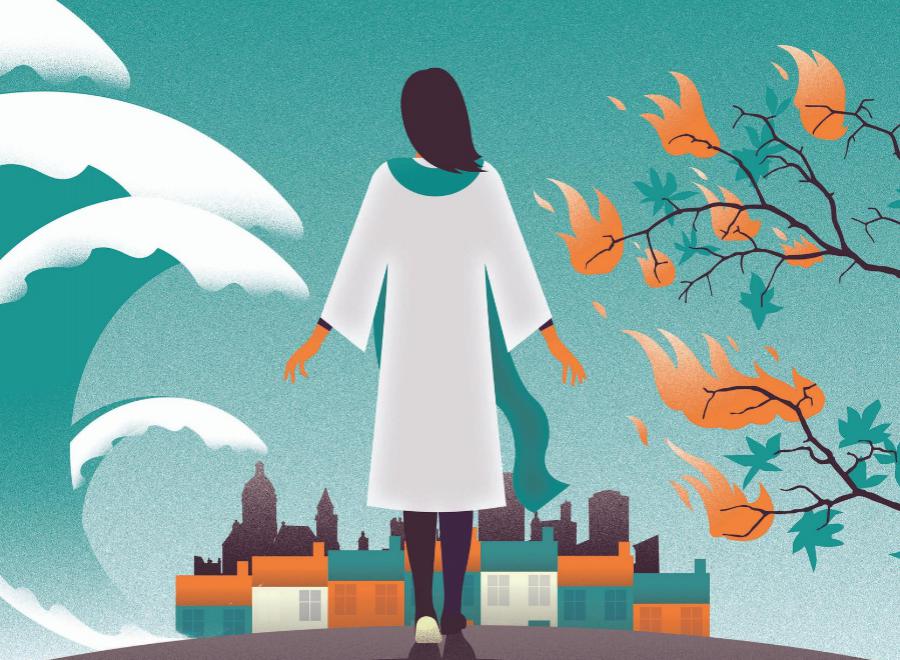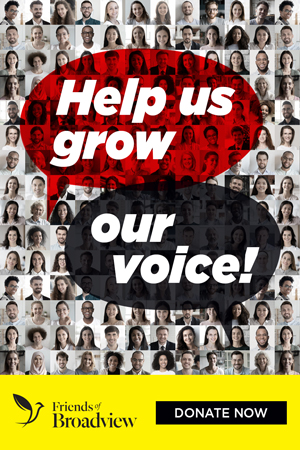Rev. David Robertson powerfully described disaster when he preached at High River (Alta.) United the first Good Friday after the 2013 flood. Just 10 months before, all 13,000 in the community had to evacuate as water devastated their town. Hundreds lost their homes. Robertson led us to the terrible trauma at the centre of the Good Friday story, then held a terra cotta planter up high. He released it, and the pot crashed to the floor, breaking into pieces. The noise cut through us like a knife. No one moved. I heard everyone’s shocked intake of air and worried it was too much for this hyper-vigilant crowd.
But Roberston trusted his people, and they trusted him. We sat still, in the wake of disaster, silent together. Then his voice spread over us, speaking what we needed to hear and what was eternally true: that as soon as the worst happens, that even while we are still holding our breath, God is at work.
When the ministry team at High River United invited me to consider a post-disaster support position in 2013, I was already studying trauma and working with trauma survivors as a volunteer. After wildfires forced nearly 90,000 to flee from Fort McMurray, Alta., in 2016, Alberta and Northwest Conference invited me there, too. Both positions were funded by donations received by The United Church of Canada for disaster relief. To the best of my knowledge, I’m still the only trauma professional in the church with this kind of training and experience — but I hope I’m not the last. I hear the news of floods and fires and ice storms and tornadoes differently now. My insides go very still, and I pray with no words.
More on Broadview: How churches can help heal the healers
Disaster work and recovery are not well understood. I like to compare it to the plate-spinning performances I remember from the old Ed Sullivan Show. Just when you thought a plate would fall from one of the performer’s spinning poles, he would grab its edge and give it another whirl. We all keep many plates spinning every day: things like parenting, relationships, health issues, debt, school, aging parents, careers, addictions, social injustices, housing needs, past traumas, volunteer commitments and more. That’s a lot to keep spinning on a good day. Now imagine you experience a natural disaster. Your community is partially destroyed. You may have lost your home, your neighbourhood, your job. Service agencies and emergency providers are overstressed and under-functioning. Bills have to be paid. The marathon to access money from insurance and any disaster recovery program begins. Inevitably, some of the plates come crashing down. It’s just too much. Each person’s experience of a disaster is unique, and which plates crash is also unique.
Over the months and years that I moved among the survivors of disaster, I sometimes heard very little about the disaster itself and a whole lot about those other plates. A big piece of my work was meeting with people one-on-one to talk, do assessments and refer them to experts to help them with their legal, mental health, medical, financial or educational needs. When I found myself without appointments, I would go for a walk and talk to the people I met. I would often go into a store and come out with a small purchase and three new appointments scheduled.
I helped people make insurance and recovery program claims. I met with mental health professionals and shared what I was learning in my work. I also helped the incumbent clergy, church personnel and lay leaders manage the stress and operational destabilization. As a minister myself, I could step in to pick up something instantly, whether it was a pastoral call, leading the Sunday school class, talking with renters, or praying or ministering to those who were needy before the disaster and remained so after. I gave everyone room to fall apart a little, adjust expectations and keep ministry going forward.

But some recovery problems don’t resolve, and new ones can arise. Homes spared the fire thanks to water bombing are soaked and uninhabitable. A spouse experiences a psychological break that does not improve. Areas are abandoned as some neighbours never return. An insurance claim is denied, and negotiations move at a snail’s pace. People realize how much they are going to lose permanently. We call this the “second disaster.” It can dig a deeper hole than the first. It often comes right about the time when generous donors want to hear success stories. It’s hard to learn about the realities of disaster and recovery. And it’s hard to share what we learn.
In Fort McMurray, I ran workshops on compassion fatigue for many government employees, local non-profits and service groups. At the start of each workshop, I introduced myself and told them that the United Church had sent me to make sure they knew that they were not forgotten, regardless of their beliefs and non-beliefs. Many times they would cry, hearing that message. By then, they knew recovery was going to be years in the making. They needed encouragement and tools to keep at it, and the support from many across the church was there in the room with them.
The whole time, I felt that support from the church, too. Donations, and the messages that came with them, made everyone feel remembered. Cards were posted in narthexes and read in worship, and some of those messages and support arrived right when we were facing roadblocks or major setbacks. The church’s love was strength in the face of daily trials.
But some recovery problems don’t resolve, and new ones can arise. We call this the “second disaster.”
In both places, there are many examples of the extraordinary leadership local United churches offered their communities while they were also suffering.
High River United hosted a once-a-month supper. They invited people from the local Lutheran church, whose pastoral leader had left, any relief workers who happened to be in town and anyone else from the community who was in need. Those who could donated to help cover costs, and all were fed with delicious food, gentle conversation and new friendships forged in the aftermath of disaster. This was especially important because post-traumatic stress symptoms can create an increased sense of isolation, degrees of agoraphobia, difficulty socializing and a hypervigilant need to feel safe. In the midst of their own personal disaster stories, members of the church supported anyone managing these and other symptoms of trauma. They helped their community heal, one shared meal at a time.
The congregation also made repairing the church building, a hub for their town, a priority. Once it was fixed up, the church provided space for hospital outreach programs, disaster recovery teams, town leaders and others whose own spaces were not yet safe for use. Many congregants and staff also served on a team to host the local annual music festival. Music from children and youth flowed out of the building for days, and everyone who passed through had their spirits lifted.
In Fort McMurray, the minister of First United, Rev. Donalee Williams, continued to lead Messy Church for community families. She also kept directing the local seniors’ choir while church volunteer Marjorie Epp accompanied on piano. One of the choir members who had lost her home turned down my offer to assist her through the administrative nightmare of getting a green light from her duplex neighbour, their insurance company and a builder to start construction. So I started singing in the choir, too, because that was the support that kept her going and calmed her down week after week.
Another United Church person, Kelvin Sawatzky, is a well-known local artist. After the fire, people brought him photographs of the disaster, and he began to paint them. Going to his gallery became a cathartic experience. He gave people a new way to carry the story.
Still others kept the food bank going, the ecumenical soup kitchen running, the high-school graduation planned and the church immaculate for renters. These are just some important stories of recovering together.
The COVID-19 pandemic is reminding me that disasters come in many forms. With the constraints of physical distancing, I started working with a videographer and producer to offer videos on how to support yourself and each other through this new reality. The key to responding is being trained, quick and flexible — but always with an eye to participating alongside God, who is already at work, healing, recreating and renewing.
This story first appeared in Broadview‘s September 2020 issue with the title “In the midst of disaster.”
Rev. Diane Strickland is a minister, community and workplace traumatologist, compassion fatigue specialist and critical incident responder who lives in Algonquin, Ont., and Calgary.
I hope you found this Broadview article engaging. The magazine and its forerunners have been publishing continuously since 1829. We face a crisis today like no other in our 191-year history and we need your help. Would you consider a one-time gift to see us through this emergency?
We’re working hard to keep producing the print and digital versions of Broadview. We’ve adjusted our editorial plans to focus on coverage of the social, ethical and spiritual elements of the pandemic. But we can only deliver Broadview’s award-winning journalism if we can pay our bills. A single tax-receiptable gift right now is literally a lifeline.
Things will get better — we’ve overcome adversity before. But until then, we really need your help. No matter how large or small, I’m extremely grateful for your support.
Jocelyn Bell
Editor/Publisher


Comments